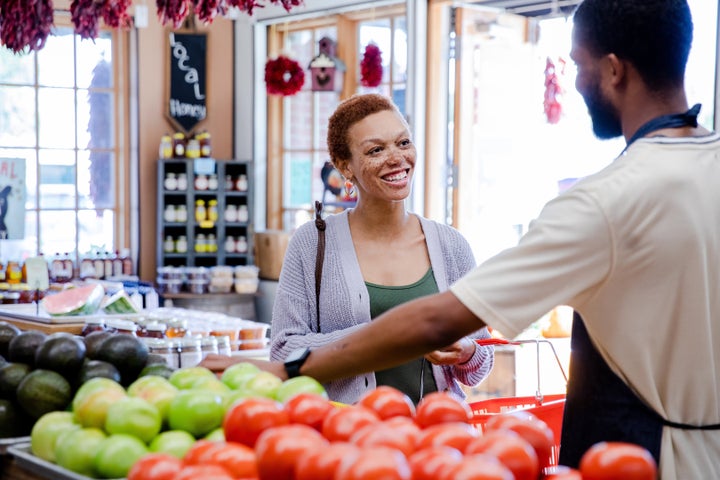
The close relationships we have with romantic partners, family, friends and even co-workers enrich our lives in countless ways. But there’s another type of connection that’s meaningful but often overlooked: the interactions we share with strangers.
Think about the Trader Joe’s cashier you chat with while they bag your groceries or the neighbour you always exchange ’good morning’s with while walking your dogs. These brief interactions may seem insignificant to you, but research has shown that’s just not true.
Hanne Collins, a Harvard Business School Ph.D. student who studies conversation, said that while close relationships provide intimacy, trust, support and emotional depth, “weak ties,” like casual acquaintances, are also an important part of our social lives.
“Weak ties connect us to other people, resources, and information that we might not have access to otherwise,” Collins told HuffPost. “Further, people confide more than we would expect in weak ties, and people actually enjoyed conversations with strangers much more than they expected to.”
Collins co-authored a 2022 study, published in the journal Proceedings of the National Academy of Sciences, about the link between our happiness and how many different kinds of relationships we maintain.
“We wanted to understand which portfolio of interactions — with which types of relationship partners, and how many interactions with each type — is most predictive of well-being,” she said.
In the study, relational diversity was measured across two metrics: richness and evenness. Richness is the number of relationship categories you converse with (family members, co-workers, strangers etc.), and evenness refers to how those conversations are distributed across different relationship categories, Collins explained.
“These results suggest that talking to strangers is a critical part of a rich and diverse social life.”
- Hanne Collins, a Harvard Business School PhD student and researcher
She offered an example: Let’s say you had 10 conversations in a day. That could be eight conversations with colleagues and two with friends. Or those 10 conversations might include two with colleagues, two with friends, two with a romantic partner, two with strangers and two with parents.
“We find that individuals with the more diverse social portfolio — people who are talking to a more varied set of relationship partners and doing so relatively evenly — experience greater well-being in terms of life satisfaction, quality of life [and] positive emotion,” Collins said. “These results suggest that talking to strangers is a critical part of a rich and diverse social life.”
Why does a diverse social life improve our well-being? Collins says there’s likely many reasons, but one of the potential explanation is because our interactions with strangers are often unplanned and unexpected, which “adds a certain element of surprise.”
“Unexpectedly sharing a joke with someone at the supermarket, or stumbling into an intimate conversation with someone on the train, or finding something in common with someone you never expected to meet — I’ve experienced each of these and struggle to describe the deep delight and joy that ensued from these unexpected encounters,” she said.
The Value Of ‘Consequential Strangers’

Melinda Blau is a journalist who covers relationships and the co-author of the book “Consequential Strangers: The Power of People Who Don’t Seem to Matter. . . But Really Do” along with psychologist Karen Fingerman. According to Blau, a consequential stranger is anyone in your social circle other than your family or close friends. Most of the people in our lives fall into this category.
“The list is long and necessarily diverse, because they come from the different arenas where you live out your life — a golf buddy, the nice lady in accounting, a neighbour,” Blau said. “Could be a supermarket checker you know by face, a commuter who catches the same train, fellow dog owner — often you know the dog’s name and elimination patterns, ‘Buster likes privacy’ — but don’t know the human’s name. You have conversations; you connect, even if by nodding or saying hello.”
Being more aware of the consequential strangers who populate your life and engaging with them helps you feel less lonely and “understand the value of all people and all kinds of social interactions,” Blau said.
“You’re more likely to look at a name tag and call a stranger by name or introduce yourself, more likely to tune in and be present,” she said. “Valuing others, wanting to connect, and having even fleeting conversations is not just good for you, it’s a key ingredient to a rich and supported life.”
“When you move to a new place, it begins to feel like home once you connect. When you have a serious problem or a disease, you turn to someone who has been through it ― for instance, in a support group. When you make friends with other new mothers in the hospital, you plan play groups,” she added.
While these casual connections could blossom into a closer relationship down the line, they don’t need to in order to be valuable, Blau said.
“They round out your life. Simply put, each one is an intermittent, sometimes unplanned, and usually enjoyable social encounter,” she said.
Talking To Strangers Introduces You To Different Kinds Of People
Sociologists have observed our tendency to surround ourselves with people who are similar to us in terms of age, race, political affiliation and other demographic categories. Connecting with strangers affords us the opportunity to interact with people who are different from us, said West Los Angeles clinical psychologist David Narang.
“As we each live more and more in homogenous social media bubbles, where posts we view and news links provided are tailored to what we want to hear, it becomes inevitable to experience differences as threatening,” Narang, author of “Leaving Loneliness,” told HuffPost. “Interacting with strangers is likely to place us in contact with differences, which can remind us that encountering differences can sometimes be pleasurable, even refreshing.”
“Consequential strangers in the wider reaches of our personal social networks expose us to new ideas and experiences, different perspectives, a greater swath of opportunities.”
- Melinda Blau, journalist and author
Blau also touched on the benefits of connecting with folks from all walks of life and how that can broaden our horizons and help us grow.
“Our intimates know what we know. In contrast, consequential strangers in the wider reaches of our personal social networks expose us to new ideas and experiences, different perspectives [and] a greater swath of opportunities,” she said. “This doesn’t mean you need a huge number of casual connections, just diversity.”
So What Stops Us From Connecting With Strangers?
Generally, people aren’t good at predicting how they’ll experience social situations, Collins noted, often assuming interactions will go poorly. For example, you might be hesitant to talk to someone standing next to you in line at the post office because you don’t want to be viewed as intrusive or have your conversational bid rejected. Or maybe you’ve grown up thinking strangers are bothersome or even potentially dangerous.
“People think talking to a stranger will be a less positive experience than it really is,” Collins said. ”People think others are less interested in making social connections with them than is the case. People underestimate the extent to which others like them and enjoy their company.”
Negative beliefs about how these interactions might go can make people less likely to engage with others — and with strangers, in particular, “because these interactions are often optional,” Collins said.
“We can choose not to interact with strangers. And they’re very uncertain. We don’t know them, so we have no idea what is going to happen,” she added.
How To Approach — And Embrace — Casual Connections

If you’d like to engage more with the people you encounter in your everyday life, start with places where people are “more obviously available for contact,” Narang said, “such as a dog park, or taking a minute with the barista at your local coffee shop when walking in during a lull.
“When at in an in-between space, such as an elevator, or standing in line, gently observe those around instead of reaching for your phone, to notice who interests you,” he said.
Of course, it’s always useful to pay attention to other people’s energy and body language before approaching them.
“It boils down to reading the room. If someone appears tense and on-the-go or is furiously texting on their phone, obviously we would be intruding to try and force a conversation,” Narang said. “However, if the other person has a more leisurely vibe, take a risk to comment on something immediately present in the environment.”
“I usually end up feeling more optimistic and positive about the world around me.”
- Collins
If you try to engage and they seem distracted or disinterested, it might sting a bit. But try not to take it personally.
“Consider that they may simply not feel available to talk, rather than assuming that it is a rejection of you personally,” Narang said. “Watch for their cues and respond accordingly.”
Collins, the Harvard Business School researcher, described herself as a “socially anxious introvert” who struggles with these types of interactions. But because of her research in this area, she said she’s made an effort to lean into the moments of social connection that pop up in her everyday life.
“I chat with the teller at the grocery store, I joined an adult guitar class, I say hi to people I pass on my walks around my neighbourhood. Even if I don’t make a lifelong friend, I leave these moments of connection feeling delighted and joyful,” she said. “I usually end up feeling more optimistic and positive about the world around me. There’s something lovely about feeling that everyone around you could potentially, someday, be a friend.”